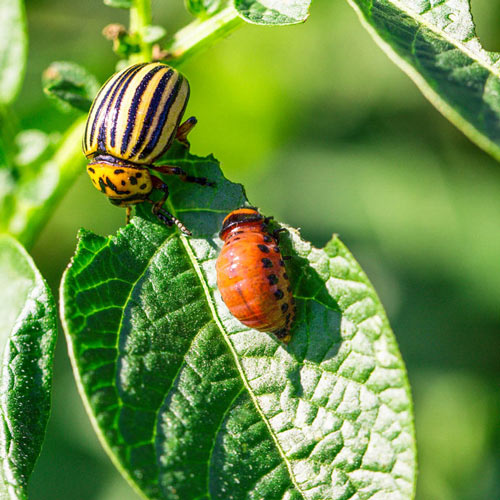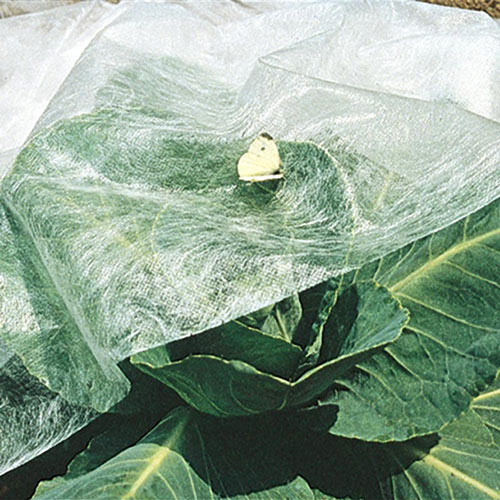The Positives and Perils of Volunteer Potatoes
-
Helpful Products from Gardens Alive!
-
 Bull's-Eye™ Bioinsecticide
Bull's-Eye™ Bioinsecticide -
 Super-Lite Insect Barrier - Lightweight Row Cover
Super-Lite Insect Barrier - Lightweight Row Cover
Q. Every fall I accidentally leave some potatoes in the ground, and the next Spring new 'volunteer' plants come up in the same spot super early in the season. I pull them out because I rotate my beds and always plan to grow something else there. But is it possible to deliberately plant potatoes in the fall and leave them in the ground over winter?
---Steve in Bucks County Pa
A. Great question. 'I think' (a dangerous phrase in general with me) that this is actually a recognized technique—planting potatoes in the fall so that, as Steve notes, the new plants come up really early in the Spring. But as with many other gardening techniques, you're probably more likely to succeed with accidental plantings than deliberate ones.
And of course, by 'accidental', I mean the small potatoes that always seem to get missed when you harvest the main crop in the fall…
Except that they're not always all that small. The past few years I've been fighting a really killer weed called Piniella that invaded some of my raised beds. (It looks like a miniature Jack in The Pulpit so I originally thought it was harmless; foolish me!) Anyway, last season I was digging out the nasty bulbous roots of this weed and embarrassedly harvested full-sized potatoes from beds I was certain I had cleaned out at harvest time!
(Potatoes just love to 'roam'. Over the years, I've learned that the best ones often appear a couple feet away from the main crop.)
But before we proceed further, let's take a little digression into potato harvest timing. You plant "seed potatoes" in the Spring, lush green plants appear above ground a month or so later and then you have two choices. Potato plants produce unbelievably beautiful flowers; prettier than eggplant flowers, which is saying something. And the colors of the flowers correspond to the color of the potatoes underground—red, purple, white, golden yellow…
Anyway, admire these flowers while they're in full bloom, then pull them off when they start to fade and note the date. Three weeks to a month afterwards you can harvest small and delicious 'new potatoes' from the soil underneath those plants. (Note: This is true of volunteers as well as 'deliberately planted' seed potatoes.)
These small 'new' potatoes are intensely sweet; and more nutritious gram for gram than the full-grown ones that you'd wait to harvest until after the first frost. But those full-grown ones give you a lot more potato for your planting and still have a much more intense flavor and juiciness than store-bought potatoes—so it's a choice with no bad options. And, of course, if you have the room, you can grow enough plants to harvest both ways.
…Which is a worthy enterprise; because either way you're going to experience a flavor that you can only get home-grown. You can generally find really good-tasting tomatoes and peppers and such at a local CSA or Farmer's Market, but you can only experience the supreme juiciness of a fresh potato by growing your own.
And back to our question, you're always going to miss some of those potatoes at harvest time. Now: Is there any reason to pull up the volunteers that appear the following year?
Only one—and that's if you had late blight on your tomatoes or potatoes the previous season. If you did experience the dread disease that caused the Irish Potato Famine of the 1800s you MUST pull up and destroy any volunteer potatoes that emerge the following year. The pathogen can't survive winter aboveground, but can and does survive underground in unharvested potatoes. (Learn more about late blight and its unique symptoms in this/these previous Question(s) of the Week.)
"But wait; there's more!"
We sent Steve an advance version of this answer and his reply kind of changes the topic. He writes: "You're correct; I feel like a murderer pulling up those 'free' taters, but this year they're right in the middle of my garlic. And while I love my taters, garlic will always come first."
Luckily, Steve might not have to make a choice. This has happened to me several times, and each of those times I have let nature take its course and prospered as a result. Garlic bulbs form fairly close to the surface, while potatoes tend to grow down deeper—especially in the good soil of a raised bed. More importantly, you're going to destroy or at least damage some of the surrounding garlic if you pull out the volunteer potato plants.
Steve has apparently already decided that 'something had to be done' and he done it. But I have let these 'double plantings' alone and gotten both good garlic and potatoes from the deal.
And, finally, what about fall planting of potatoes?
I've never done it intentionally; and you're probably not going to easily find certified disease-free seed potatoes for sale in the Fall. So I suggest a middle ground. Plant potatoes in the Spring, but do so where you're not going to desperately need that bed the following season. Then wait to plant anything else in that bed the following year until well after any volunteers should be obvious.
If you get volunteers, let them grow. If not, plant something else there.
---Steve in Bucks County Pa
A. Great question. 'I think' (a dangerous phrase in general with me) that this is actually a recognized technique—planting potatoes in the fall so that, as Steve notes, the new plants come up really early in the Spring. But as with many other gardening techniques, you're probably more likely to succeed with accidental plantings than deliberate ones.
And of course, by 'accidental', I mean the small potatoes that always seem to get missed when you harvest the main crop in the fall…
Except that they're not always all that small. The past few years I've been fighting a really killer weed called Piniella that invaded some of my raised beds. (It looks like a miniature Jack in The Pulpit so I originally thought it was harmless; foolish me!) Anyway, last season I was digging out the nasty bulbous roots of this weed and embarrassedly harvested full-sized potatoes from beds I was certain I had cleaned out at harvest time!
(Potatoes just love to 'roam'. Over the years, I've learned that the best ones often appear a couple feet away from the main crop.)
But before we proceed further, let's take a little digression into potato harvest timing. You plant "seed potatoes" in the Spring, lush green plants appear above ground a month or so later and then you have two choices. Potato plants produce unbelievably beautiful flowers; prettier than eggplant flowers, which is saying something. And the colors of the flowers correspond to the color of the potatoes underground—red, purple, white, golden yellow…
Anyway, admire these flowers while they're in full bloom, then pull them off when they start to fade and note the date. Three weeks to a month afterwards you can harvest small and delicious 'new potatoes' from the soil underneath those plants. (Note: This is true of volunteers as well as 'deliberately planted' seed potatoes.)
These small 'new' potatoes are intensely sweet; and more nutritious gram for gram than the full-grown ones that you'd wait to harvest until after the first frost. But those full-grown ones give you a lot more potato for your planting and still have a much more intense flavor and juiciness than store-bought potatoes—so it's a choice with no bad options. And, of course, if you have the room, you can grow enough plants to harvest both ways.
…Which is a worthy enterprise; because either way you're going to experience a flavor that you can only get home-grown. You can generally find really good-tasting tomatoes and peppers and such at a local CSA or Farmer's Market, but you can only experience the supreme juiciness of a fresh potato by growing your own.
And back to our question, you're always going to miss some of those potatoes at harvest time. Now: Is there any reason to pull up the volunteers that appear the following year?
Only one—and that's if you had late blight on your tomatoes or potatoes the previous season. If you did experience the dread disease that caused the Irish Potato Famine of the 1800s you MUST pull up and destroy any volunteer potatoes that emerge the following year. The pathogen can't survive winter aboveground, but can and does survive underground in unharvested potatoes. (Learn more about late blight and its unique symptoms in this/these previous Question(s) of the Week.)
"But wait; there's more!"
We sent Steve an advance version of this answer and his reply kind of changes the topic. He writes: "You're correct; I feel like a murderer pulling up those 'free' taters, but this year they're right in the middle of my garlic. And while I love my taters, garlic will always come first."
Luckily, Steve might not have to make a choice. This has happened to me several times, and each of those times I have let nature take its course and prospered as a result. Garlic bulbs form fairly close to the surface, while potatoes tend to grow down deeper—especially in the good soil of a raised bed. More importantly, you're going to destroy or at least damage some of the surrounding garlic if you pull out the volunteer potato plants.
Steve has apparently already decided that 'something had to be done' and he done it. But I have let these 'double plantings' alone and gotten both good garlic and potatoes from the deal.
And, finally, what about fall planting of potatoes?
I've never done it intentionally; and you're probably not going to easily find certified disease-free seed potatoes for sale in the Fall. So I suggest a middle ground. Plant potatoes in the Spring, but do so where you're not going to desperately need that bed the following season. Then wait to plant anything else in that bed the following year until well after any volunteers should be obvious.
If you get volunteers, let them grow. If not, plant something else there.
-
Helpful Products from Gardens Alive!
-
 Bull's-Eye™ Bioinsecticide
Bull's-Eye™ Bioinsecticide -
 Super-Lite Insect Barrier - Lightweight Row Cover
Super-Lite Insect Barrier - Lightweight Row Cover







 Gardens Alive! & Supplies
Gardens Alive! & Supplies




